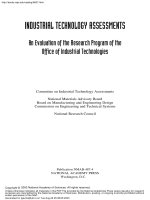the principles of industrial management
Bạn đang xem bản rút gọn của tài liệu. Xem và tải ngay bản đầy đủ của tài liệu tại đây (8.26 MB, 362 trang )
Curru'll
UiKV iMtv L ilu
TS
156.
D84
Trio principals
of
induslri.il ii).in,iqt.'mrnl.
i':)j-i
[){).'
:-\H S.l
Digitized by Microsoft®
THE
LIBRARY
OF THE
NEW
YORK STATE
SCHOOL
OF
INDUSTRIAL AND
LABOR
RELATIONS
AT
CORNELL
UNIVERSITY
Digitized by Microsoft®
This book was digitized by Microsoft Corporation in
cooperation with Corneii University Libraries, 2007.
You may use and print this copy in iimited quantity
for your personai purposes, but may not distribute or
provide access to it (or modified or partiai versions of it)
for revenue-generating or other commerciai purposes.
Digitized by Microsoft®
The original of tliis book is in
tine Cornell University Library.
There are no known copyright restrictions in
the United
States
on the
use
of the text.
/>Digitize by Microsoft®
THE PRINCIPLES OF
INDUSTRIAL
MANAGEMENT
Digitized by Microsoft®
Digitized by Microsoft®
THE
PRINCIPLES
OF
INDUSTRIAL
MANAGEMENT
BY
JOHN
C. DUNCAN, M.S., Ph.D.
ASSISTANT PROFESSOR
OF
ACCOUNTANCY,
treiVERSITV OF ILLINOIS
NEW
YORK
AND LONDON
D.
APPLETON
AND COMPANY
Digitized t>i'9^ksoft®
Copyright,
19Z1,
by
D. APPLETON
AND COMPANY
Printed in the United States of America
Digitized by Microsoft®
THIS BOOK
IS DEDICATED
TO ITS TWO
MOST INTERESTED WELL-WISHERS-
MY
PARENTS
Digitized by Microsoft®
Digitized by Microsoft®
PREFACE
The writer has long felt the need of
a scientific
treatment
of industrial management. Hundreds of
young men
are
now
in our schools and colleges intending
to
engage
in the
world
of affairs, and
it is exceedingly important
that
they gain
a
clear conception of the
principles underlying the successful
conduct
of industrial enterprises.
The
material in this book is gathered from many sources.
Merely to
mention the people to whom the author is indebted
for data
within these
covers would fill several pages with
names.
The writer has
endeavored to give full credit in the
text for the
drawings, plates, and
diagrams, and, unless ac-
cidentally overlooked,
all books and
articles from which he has
received
assistance have
been cited. In
the text, however,
there is no
mention of his
obligations to Judge
Elbert H. Gary
and Mr.
Richard
Trimble, of the
United States Steel
Corpora-
tion,
to Mr.
Wm.
Laughlin, of
Armour and
Company, Mr. H.
C.
Folger, Jr.
,
of the
Standard Oil
Company, Mr. E.
Collins,
Jr.,
of
the
Sauquoit
Silk
Manufacturing
Company, Mr. L.
A.
Osborne,
Vice-President
of the
Westinghouse
Electric and
Manufacturing
Company,
and
Mr. H. E.
Neise, of the
Amer-
ican
Sugar
Refining
Company; so he
takes
this opportunity
to
thank
them
for their
many favors.
He is
further indebted
to
his
colleagues
in
the
departments
of Economics and Engi-
vii
Digitized by Microsoft®
viii PREFACE
neering
of the University of Illinois, to
his
former
associates
at the University of Pennsylvania and Ohio
State
University.
Professors E. H. Waldo and E. L.
Bogart, his
colleagues
at
the University of Illinois,
have
been very
helpful;
the
former read
all
the chapters
pertaining to the
engineering
matters,
in addition to many
of
the
others.
Professor
Emory
E. Johnson, his former teacher at
Pennsylvania,
read the
entire
manuscript,
and made many
improvements
in
style
and
expression. This
paragraph would be
incomplete
with-
out special mention
of his sister, to whom the
writer is
indebted
for the work of preparing the manuscript
for the
printer.
In
addition to that onerous task she has
given
many suggestions as to form, expression, and
selection of
contents, which have been of very great assistance.
In
registering his
thanks, however, the writer does not
wish
to have anyone but himself blamed for any
deficiencies
which
exist
in
the volume,
as the plan and treatment
are his
own.
It
is his hope that the book will
be of service
to the stu-
dents of accountancy as well as to those of
general
business.
The
accountant should have
knowledge of more
than
the
mere methods of making entries in books
and the
drafting
of financial
statements
therefrom. He
should
be able
to
appreciate the kind of information
which the
management
needs,
and the extent "to which accounting
records
can
gather
the various types of
information.
The
book is
written
to
give both the
accoimtant
and the general
student of
business
a
brief
presentation of the underlying
principles
of
the
sci-
ence of
management.
In
teaching the subject the
writer has
found
it
exceed-
Digitized by Microsoft®
PREFACE ix
ingly helpful
to the instructor and profitable
to
the student
to have
frequent visits
to modern plants and then have care-
fully written reports presented which discuss those factors
which
contribute to
the success
of
the enterprise or tend to
its
failure. Such trips should be made with the teacher or
with
some
competent
guide,
and may well be made the basis
of interesting class-room
discussion.
John C.
Duncan.
Univeesity of
Illinois, Ukbana, III.
December
1,
1910.
Digitized by Microsoft®
Digitized by Microsoft®
CONTENTS
PART
I.—
THE
ECONOMIC
ENVIRONMENT
CHAPTER
I
THE
PROBLEMS
PAGES
Introduction
—Factors
Affecting
Prosperity
of Plant
—Eco-
nomic Environment
—
Manufacturing
and
Distributive
Policy
—
Organization
and
Management
—Problems
of
Business
Management:
(1)
Location of
Plant;
(2)
Integration and
Concentration
of Business
;
(3)
Special-
ization;
(4)
Building;
(5)
Power;
(6)
Management;
(7)
Selling
3-4
CHAPTER II
GENERAL THEORY OF INDUSTRIAL
LOCATION
Survey of Concentration and
Localization
of Industries
—
Reasons
for Localization
—
Census
Classification
:
(1)
Materials;
(2)
Market;
(3)
Water
Power;
(4)
Climate;
(5)
Labor Supply
;
(6)
Free Capital
;
(7)
Early Start-
Four Primary Reasons for
Localization
:
(1)
Market
;
(2)
Raw Materials
;
(3)
Labor
;
(4)
Power
—
Importance of
Latter Factors
5-23
CHAPTER III
THEORY OF PLANT LOCATION
Factors
Other
than the Ideal
Industrial District
Affecting
Success of
Plant—Location, Layout, Equipment—Loca-
tion
with Respect to Selling,
Buying, Manufacturing
—
Importance
of Nearness to Labor Population,
Repair
Shops,
Banking and
Credit
—
Considerations Affecting
xi
Digitized by Microsoft®
xii CONTENTS
PAGES
Building
of Plant
:
(1)
Special Needs
of
Industry
;
(2)
Space
for Expansion;
(3)
Low
Rent
and
Taxes;
(4)
Freedom
from Restrictive
Ordinances;
(5)
Adequate
Fire-Fighting
Facilities
24r-38
CHAPTER IV
THE
IDEAL SITUATION
Country, City, and
Suburban
Plant
Situations—
Advantages
and Disadvantages
—
Location of
Plants Suited to
Each
Kind of Situation
—Extra
Inducements
Offered:
(1)
Free Land;
(2)
Free
Building;
(3)
Exemption
from
Taxation;
(4)
Stock
Subscription;
(5)
Cash Bonus;
(6)
Miscellaneous Favors
—
General Rules for
Location in
Any Situation
39-48
CHAPTER
V
BUSINESS
CONCENTRATION AND INTEGRATION
Classes of Consolidations:
(1)
Integration
of Process from
Raw Material
to
Finished Product
;
(2)
Integration
and
Concentration
of
Factories
;
(3)
Integration and
Con-
centration of Distributing Houses
;
(4)
Integration
by
By-Product Utilization
;
(5)
Integration and
Concentra-
tion
by Control of Patents and Market Ownership
—
Illustrations
of
Each
Form of Consolidation
Showing
Types of Integration and
Concentration
Used—Deter-
mination
of the Advisable Type
of Consolidation.
.
49-70
CHAPTER
VI
BUSINESS
SPECIALIZATION
Growth of Specialization
—
Reasons
:
(1)
Reduction
of Prelim-
inary Cost
;
(2)
Use of Specialized
Equipment
; (3)
Sim-
plification
of Managerial Problems
;
(4)
Greater
Value
of Small Savings—Illustrations of Methods
of
Saving
—
The
Interchangeable Part
—Limitations
to
Specializa-
tion
71-80
Digitized by Microsoft®
CONTENTS
xiii
PART II.—THE EQUIPMENT OF
THE PLANT
CHAPTER
VII
CONTINUOUS INDUSTRIES, SYNTHETICAL
PAGES
Determination of the Type of Plant
—
Two Kinds of Manu-
facturing
:
(1)
Continuous
;
(2)
Assembling
—Classes of
Continuous Industries
:
(1)
Synthetical
;
(2)
Analytical
—
^A
Continuous
Synthetical Industry
of
Non-By-Product
Type—Effect upon Plant Structure—A Continuous In-
dustry
of By-Product Type
—
^Effect upon Plant Struc-
ture
81-100
CHAPTER VIII
CONTINUOUS
INDUSTRIES, ANALYTICAL
Utilization of Cheap Conveying
Apparatus
by Analytical In-
dustries
—
Two
Types
of Analytical Industries, Non-By-
Product and By-Product—
Non-By-Product Industry,
Sugar
Refining
—
Characteristics of a
Sugar-Refining
Building—
Utilization of Gravity
—
Conveying
Apparatus
in Flour
Milling—By-Product Analytical
Industry, Meat
Packing
—
Steps of the Process—
Ideal Layout for a
Packing House. .
101-114
CHAPTER IX
ASSEMBLING INDUSTRIES
Two Groups
of
Assembling
Industries:
(1)
Direct Pro-
ducing;
(2)
Indirect
Producing
—
Characteristics of As-
sembling
Industries—Two
Questions in
Assembling
Plant
Layout:
(1)
The
Arrangement
of
Departments;
(2)
The
Building
of
the Plant—
Direct
Producing In-
dustry: Shoe
Manufacturing—Ideal
Layout—
Indirect
Industry :
Ship
Building—Type
of Machinery
and
Equip-
ment
Needed—Ideal
Layout for a
Machine Shop
and
Foundry—
Ideal Layout
for a Ship
Building
Establish-
ment
115-134
Digitized by Microsoft®
xiv CONTENTS
CHAPTER
X
FIRE PRECAUTION,
AND ITS
EFFECT ON
LAYOUT
AND
STRUCTURE
PAGES
The Ideal Plant—
Large Changes
in
Plant
Layouts
Neces-
sitated by
Fire
Precautions
:
(1)
In
Oil
Refineries
;
(2)
In
Gas Works—
Causes of
Fire:
(1)
Common
Hazards;
(2)
Special
Hazards—
Fire
Protective
Devices
:
(1)
Pre-
ventives of
Fire;
(a)
Slow-Burning
and
Fire-Proof
Structures;
(2)
Fire
Extinguishers:
(a)
Automatic
Sprinklers,
(b)
Fire Hose,
(c) Fire
Buckets,
(d)
Chem-
ical
Extinguishers, (e)
Hand Buckets
;
(3)
Fire Alarms
:
(a) The
Watchman
and the Time-Recorder, (b)
Ther-
mostats
—
Outside
Fire
Protection:
(1)
Water Curtains;
(2)
Fire
Hydrants
;
(3)
Fire Alarms
;
(4)
Fire Engines
—
Safety
Devices for
the Protection
of
Life:
(1)
Fire
Escapes
;
(2)
Fire
Drills
135-152
CHAPTER XI
THE
BUILDING AND THE WORKERS
Five Essentials to
Comfort:
(1)
Light;
(2)
Heat;
(3)
Ven-
tilation
;
(4)
Space
;
(5)
Conveniences—Lighting
:
(1)
Skylight
;
(2)
Windows
;
(3)
Saw-Tooth Lights
;
(4)
Arti-
ficial Light;
(5)
Elimination of Shadows—Heating:
(1)
Hot Air
;
(2)
Hot Water
;
(3)
Steam
;
(4)
Combination
of Hot Air and Steam—
Humidifiers
—Schemes for Ven-
tilation
—
Importance
of
Sufiicient*.
Space—
Toilet
and
Wash
Rooms. .
153-162
CHAPTER XII
THE POWER PROBLEM
Water
Power—Advantages of Purchased
Power
—Other
Forms of Power—
Direct Combustion
and Indirect
Com-
bustion
Engines
—
^The
Gas Engine
—
Two Types
of
Steam
Engine
:
(1)
Turbine
;
(2)
Reciprocating
—Econ-
omies in a Steel
Plant:
(1)
Making
Water Suitable
for
Steam
;
(2)
Increasing Boiler Efficiency
;
(3)
Increasing
Engine Efficiency—
Comparison of Boiler
Compounds
Digitized by Microsoft®
CONTENTS
XV
FACES
with
Water
Softeners—
Economizers
and
Superheaters
—
The
Automatic
Stoker—
The
Condenser—Kinds
of Power
Transmission:
(1)
Steam;
(2)
Belt;
(3)
Rope Drive;
(4)
Electrical
;
(5)
Air
Pressure
163-180
PART III.—
ORGANIZATION
AND MANAGEMENT
CHAPTER
XIII
THE THREE TYPES
OP ORGANIZATION
Duties
of the Ideal
Manager—Three
Types of Management
:
(1)
Military;
(2)
Functional;
(3)
Departmental—
Ad-
vantages and
Disadvantages
of Each
Type. . .
181-195
CHAPTER
XIV
THE LABOR FORCE
Three
Kinds of
Laborers :
(1)
Men
;
(2)
Women
;
(3)
Chil-
dren
—Male and Female Labor Compared
—
Children as
Employees
—
Classes of
Labor
from Standpoint of Edu-
cation
and
Training
—
Apprenticeship Systems—Baldwin
Locomotive Works
—
Westinghouse Manufacturing
Co.
—
Advantage in Training Apprentices
196-213
CHAPTER
XV
THE PAYMENT "OF
THE
WORKMAN
Obtaining the Maximum
Product
—
Systems of Wage Pay-
ment:
(1)
Time;
(2)
Piece;
(3)
Gain Sharing;
(4)
Premium
;
(5)
Halsey and
Rowan
Modifications
;
(6)
Differential Piece
Rate;
(7)
Emerson;
(8)
Bonus
—
Dan-
ger
of Cheap Labor
214-232
CHAPTER XVI
RECORD OF
THE WORKERS
Necessity
of Accurate
Records—
Work of the Labor Bureau
:
(1)
Selection
of
Employees
;
(2)
Record of
Their Status
—Necessity
of
Considering an
Employee's Health, Age,
Digitized by Microsoft®
xvi
CONTENTS
Education,
and
Experience
—
Sources
of
Information
—
The Form Letter
—
Qualifications
of a
Good
Employee:
(1)
Regular Attendance
;
(2)
Diligence
;
(3)
Efficiency—
Time-Recording
Systems :
(1)
Inboard,
Outboard
Check
;
(2)
Drop Box Check
;
(3)
Call
Number
;
(4)
Distribution
Check
;
(5)
Recording Clock—Proof
of
Each
System's
Accuracy—
Record of Spoiled
Work
233-261
CHAPTER XVII
RECORD OF RAW
MATERIALS
Direct and Indirect Materials
—
Care of
Raw Materials
:
(1)
Prevention of Waste and Losses on
Direct
Material
; (2)
Prevention
of Undue Expenditures
for
Indirect
Material
—
Consideration
in Development
of the
Greatest Econ-
omy:
(1)
Market;
(2)
Quality;
(3)
Quantity;
(4)
Delivery
;
(5)
Housing
;
(6)
Waste
;
(7)
Losses—
Depart-
ments:
(1)
Purchasing;
(2)
Testing;
(3)
Receiving
and
Store-room
—
The Perpetual Inventory—
Arrangement of
Stock—Prevention of Waste and Loss
—
Requisition
Scheme—The Budget System
262-280
CHAPTER XVIII
RECORD
OF
FINISHED AND
UNFINISHED GOODS
Necessity for Record of Unfinished Goods
—Two
Kinds of
Manufacturing:
(1)
For
General
Stock;
(2)
For
Specific
Contract—^Accurate Records of Partly
Finished Goods
—
The
Production Order
—The Summary
Cost Sheet
—
Rela-
tion to the
Production
Order 281-293
CHAPTER
XIX
RECORD OF
EQUIPMENT
Divisions of Equipment
:
(1)
Tools
;
(2)
Patterns
; (3)
Draw-
ings and
Plans
;
(4)
Power
Machinery
—Arrangement
arid
Classification of Tools
—Record of
Patterns
—Record
of Drawings—Dewey Decimal
System
—Record of
Ma-
chines—Types of Recording
Instruments
—A
Machine
Inventory for Fire Purposes
294-316
Index
317
Digitized by Microsoft®
LIST
OF
ILLUSTRATIONS
FAGB
Map of the United
States
Showing
Value
of
Products
of
Manufactures
per
Square
Miles
in
1900
7
Map of
the United
States
Showing
Distribution
of
the
Population in
1900
19
Map of a Portion of
the City
of
Philadelphia
27
Map of the
Carnegie
Company
Plants
29
Map of the
United States
Showing
Properties
of
Sub-
sidiary
Companies
of
United
States
Steel
Corporation
in 1908
Facing
52
Map of the United
States Showing
Refineries
of
the Standard
Oil Company and
its
Competitors
60
Diagram of
Cotton
Manufacture
86
Diagrams of
Two Types of
Cotton
Manufacturing
Plants
90
Diagram Showing
the
Steps in Steel Making
93
Plan of
the
Steel Plant at
Gary, Indiana
96
Sugar
Refinery
Scheme
104
Plan of a
Sugar Refinery
106
Plan of a Packing
House
Ill
Bird's-Eye
View of the Plant of Armour
& Co Facing
112
Shoe Manufacturing
123
Horizontal Boring, Milling,
and Drilling Machine
129
Plan of a Shipyard
132
Bird's-Eye
View of an Oil Refinery Facing
136
Elevation
and Plan of Slow-Burning Construction 143
A
Remarkable
Fire Test
Facing
145
Interior of a Machine
Shop
Facing 154
A
Ventilation
and
Heating
Plan
157
Inside
View
of the
Eureka Water
Softener
171
Comparison
of the
Time-Rate and
Piece-Rate Systems 217
Comparison of Halsey and Rowan
Premium Plans
222
Taylor Differential Piece-Rate System
226
Emerson Differential Piece-Rate
System
228
2 Digitized
iijctkl/brosoft®
xviii
LIST OP
ILLUSTRATIONS
PAGE
Recording Clock
with Cost
Equipment
243
Workmen's
Monthly Time Book
245
Daily
Analysis Sheet
246
Daily Tiirie
Distribution Ticket
247
Monthly Time Cost
Sheet
248
Individual
Contract Time Slip
249
Non-Detachable
Contract Time Record
Tag
250
Detachable Contract
Time Record Tag
252
Individual
Operation Time Slip for
each
Contract
253
Monthly Wage Record
of
Piece-Worker
254
Monthly
Memorandum Card Showing
Efficiency
of Piece-
worker
255
Individual Spoiled Work
Ticket
256
Permanent Record
Card of Employees
257
Report
Summarizing Spoiled Work of Entire Plant by
Depart-
ments
258
Chart
of Errors Showing
Monthly
Efficiencies
of Departments 259
Detailed Monthly Spoiled Work Report for
each Department
260
Index Record for Keeping Track of Customers and
Wearing
Qualities of
Raw Materials
265
Purchase Record Used to Determine Source of
Defective
Raw
Material 267
Raw
Material Stock Record
,
269
Works
Requisition on Store Room
274
Budget Blank for a Machine Shop
278
Record Slip Showing Amount of
Goods
which Passed
Through
a
Department in
Bulk
284
Combined
Cost Ledger
and Partly Finished
Goods
Record for
Goods
which Pass Through
Departments
in Bulk
286
Partly
Finished Goods Record
288
Combined Partly Finished
Goods Record and
Cost
Ledger
290
Combined Sales Record and
Finished Goods
Inventory
292
Pattern Record Card
302
Record Card
of
a Bristol Automatic
Time
Recorder
307
Chart of
a Bristol
Recording
Thermometer
in a
Heating
Plant
309
Records Showing
Output of Machines
311
Machinery and Equipment
Record
Card
313
Plat Record of Machinery
and
Equipment
315
Digitized by Microsoft®
PART
ONE
THE
ECONOMIC
ENVIRONMENT
Digitized by Microsoft®
Digitized by Microsoft®
CHAPTER I
THE PROBLEMS
Industrial plants and business houses
of various
kinds
grow
and decay.
Industries prosper
in some sections
of the
country,
while in
others they
have
either
failed or are
living
a
miserable existence. The
censiis
reports at times
show
certain
territory having a most
remarkable
development
in
production
which a decade
before
was unknown in the
manu-
facturing
world. Within the same area industries
pass from
one set
of owners
to another. Frequently
within a genera-
tion,
unknown
workmen advance to
the proprietorships of
plants. Great
establishments, whose
positions were once
impregnable
and whose influences were enormous,
have lived
to see
their
power pass to other concerns prospering
under
different regimes.
Why do
industries move from one section of the country
to
another?
Why is it
that firms
in the section wherein the
industries
are located
rise and frequently fail
after having
built up a
large
business and established a national
or even
world-wide
reputation?
The
prosperity
of an enterprise
depends
in general
upon
four
factors
:
1. The
economic environment.
2.
The
equipment of
the plant.
3.
The
organization and
management
of
the
plant.
4. The selling
department.
The economic
environment
provides convenient situations
which make
possible the
cheap
production and
profitable
disposal
of
the good|,^g,.^^g^
^^
^,.^^„3„^
3









